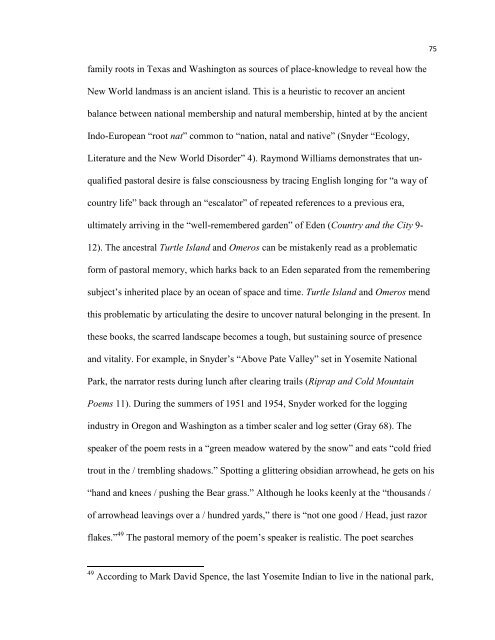RE-INHABITING THE ISLANDS - The University of North Carolina at ...
RE-INHABITING THE ISLANDS - The University of North Carolina at ...
RE-INHABITING THE ISLANDS - The University of North Carolina at ...
Create successful ePaper yourself
Turn your PDF publications into a flip-book with our unique Google optimized e-Paper software.
75<br />
family roots in Texas and Washington as sources <strong>of</strong> place-knowledge to reveal how the<br />
New World landmass is an ancient island. This is a heuristic to recover an ancient<br />
balance between n<strong>at</strong>ional membership and n<strong>at</strong>ural membership, hinted <strong>at</strong> by the ancient<br />
Indo-European ―root n<strong>at</strong>‖ common to ―n<strong>at</strong>ion, n<strong>at</strong>al and n<strong>at</strong>ive‖ (Snyder ―Ecology,<br />
Liter<strong>at</strong>ure and the New World Disorder‖ 4). Raymond Williams demonstr<strong>at</strong>es th<strong>at</strong> unqualified<br />
pastoral desire is false consciousness by tracing English longing for ―a way <strong>of</strong><br />
country life‖ back through an ―escal<strong>at</strong>or‖ <strong>of</strong> repe<strong>at</strong>ed references to a previous era,<br />
ultim<strong>at</strong>ely arriving in the ―well-remembered garden‖ <strong>of</strong> Eden (Country and the City 9-<br />
12). <strong>The</strong> ancestral Turtle Island and Omeros can be mistakenly read as a problem<strong>at</strong>ic<br />
form <strong>of</strong> pastoral memory, which harks back to an Eden separ<strong>at</strong>ed from the remembering<br />
subject‘s inherited place by an ocean <strong>of</strong> space and time. Turtle Island and Omeros mend<br />
this problem<strong>at</strong>ic by articul<strong>at</strong>ing the desire to uncover n<strong>at</strong>ural belonging in the present. In<br />
these books, the scarred landscape becomes a tough, but sustaining source <strong>of</strong> presence<br />
and vitality. For example, in Snyder‘s ―Above P<strong>at</strong>e Valley‖ set in Yosemite N<strong>at</strong>ional<br />
Park, the narr<strong>at</strong>or rests during lunch after clearing trails (Riprap and Cold Mountain<br />
Poems 11). During the summers <strong>of</strong> 1951 and 1954, Snyder worked for the logging<br />
industry in Oregon and Washington as a timber scaler and log setter (Gray 68). <strong>The</strong><br />
speaker <strong>of</strong> the poem rests in a ―green meadow w<strong>at</strong>ered by the snow‖ and e<strong>at</strong>s ―cold fried<br />
trout in the / trembling shadows.‖ Spotting a glittering obsidian arrowhead, he gets on his<br />
―hand and knees / pushing the Bear grass.‖ Although he looks keenly <strong>at</strong> the ―thousands /<br />
<strong>of</strong> arrowhead leavings over a / hundred yards,‖ there is ―not one good / Head, just razor<br />
flakes.‖ 49 <strong>The</strong> pastoral memory <strong>of</strong> the poem‘s speaker is realistic. <strong>The</strong> poet searches<br />
49 According to Mark David Spence, the last Yosemite Indian to live in the n<strong>at</strong>ional park,
















